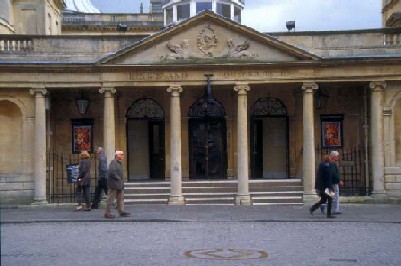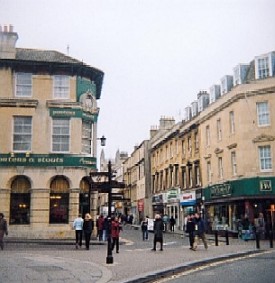|
|
|
| Home | Roman Bath | Dark Ages | Middle Ages | Upheaval | Georgian | Nineteenth century | Twentieth century | Twenty first century |
| Bath in the Middle Ages 1100-1500AD |
|
A centre of the cloth industry
|
|
|
For amazing computer rendering of how medieval Bath might have looked, check out Bath Uni's work: http://www.bath.ac.uk/Centres/CASA/medieval.htm History never felt so solid! the Abbey as a point of reference makes the medieval city easy to picture. |
|
The new Abbey...
Bishop King began rebuilding the Abbey in 1499 - then in 1539 Bath lost its monastic community in the dissolution of the monasteries carried out on the orders of Henry VIII. Power to the citizens The Abbey church and all its associated property was sold to a Bath citizen, and authority passed to the civil powers. Then in 1590 Elizabeth I granted further powers - full power over a large area including not just Bath but Walcot and parts of the north-west. |
 The extent of the medieval city The extent of the medieval city
The medieval city was tiny. The Abbey stood in the centre, and the walls were but a hundred yards or so beyond. Entry to Bath was through the various city gates. Of these, only one survives - the East Gate, way below normal floor level - between the Guildhall and the river Avon. The northern wall of the city is discernible in the line of Upper Borough Walls - the North gate itself long gone from its site somewhere between what is now Habitat store and the Podium shopping centre. Westgate Street, shown below, gives an idea of the western extent of the walled city. Sawclose (lumber yard) would have been outside the walls. |
 Medieval entertainments Medieval entertainments
The hot baths prospered in medieval times - the Kings Bath in the centre of town filled with bathers seeking a cure for a host of debilitating conditions. The open air bath was overlooked by the street, enabling passers-by to throw food, rubbish and even dogs and cats into the water. The beggars of Bath By the power of the Elizabethan Poor Law Acts, the poor and sick had free access rights to certain traditional places of healing - Buxton, in Lincolnshire, and Bath. People flocked to Bath in their hundreds - especially when, in the 1500s, many pamphlets were issued telling of the amazing medicinal powers of the hot springs. One good outcome of Bath's increased popularity was that the baths were better maintained - as they had not been since the departure of the Romans some eleven centuries before. |
 The city as described by visitors The city as described by visitors
I am indebted to Meg Hamilton and her book, Bath before Beau Nash, for insights into this generally glossed-over period in the city's history. To get the full picture I heartily recommend this volume. Links: For a huge and immensely useful list of quality medieval sources - check out the Fordham Medieval Internet Sourcebook at http://www.fordham.edu/halsall/sbook1n.html |
Last updated 21 February, 2001
FabledCity by
For the Kings and Queens Baths photo, thanks to Ian
Britton and
![]()
| Home | Roman Bath | Dark Ages | Middle Ages | Upheaval | Georgian | Nineteenth century | Twentieth century | Twenty first century |